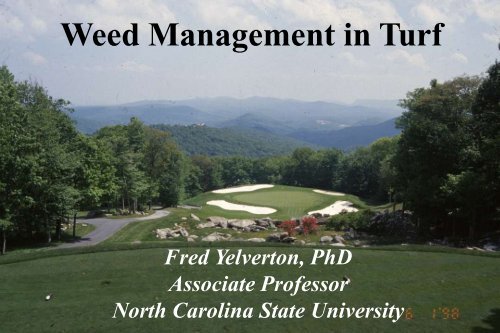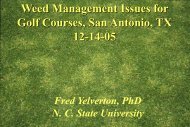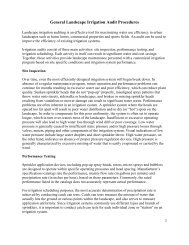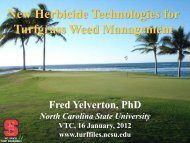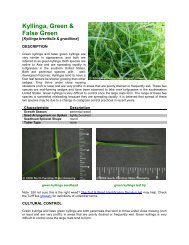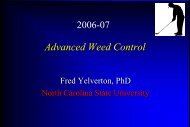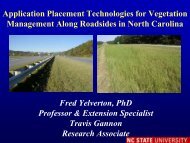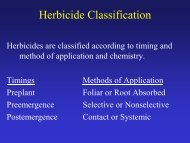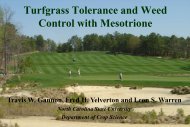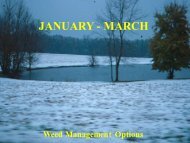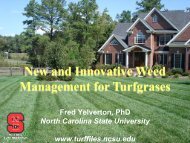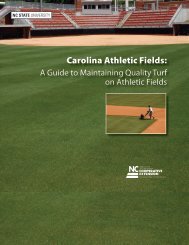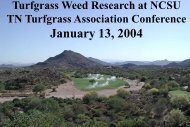Tall Fescue - TurfFiles - North Carolina State University
Tall Fescue - TurfFiles - North Carolina State University
Tall Fescue - TurfFiles - North Carolina State University
Create successful ePaper yourself
Turn your PDF publications into a flip-book with our unique Google optimized e-Paper software.
Weed Management in TurfFred Yelverton, PhDAssociate Professor<strong>North</strong> <strong>Carolina</strong> <strong>State</strong> <strong>University</strong>
Turf Species‣Warm-Season:‣Bermudagrass‣Zoysiagrass‣Centipedegrass‣St. Augustinegrass
Turf Species‣Cool-Season:‣<strong>Tall</strong> <strong>Fescue</strong>/Bluegrass‣<strong>Tall</strong> <strong>Fescue</strong>/Bluegrass/Fine <strong>Fescue</strong>‣<strong>Tall</strong> <strong>Fescue</strong>‣Bentgrass
Highlyadapted turfspeciesreduceweedinfestations
<strong>Tall</strong> fescuemowed at 3.5inches had only5-10% crabgrasswhereas 1 inchmowing ht hadabout 80%crabgrass
Annualbluegrass hasstrong lightrequirementfor seedgermination
Mustresolvedrainageproblemsbeforeeradicatingsedges
Sedges,particularlygreenkyllinga,thrive inwet areas
Weeds as Indicators‣ Low soil pH‣ High soil pH‣ Droughty soils‣ Wet soils(overwatering)‣ Poor(sandy) soils‣ Red Sorrel‣ Plantains‣ Prostrate Spurge, Black Medic,Knotweed, Woodsorrel, Lespedeza,Bracted Plantain‣ Sedges, Poa annua, Alligatorweed,Moss, Algae, Goosegrass‣ Quackgrass, Poorjoe, sandspur
Weeds as Indicators (cont.)‣ High Nematodes‣ Low Mowing Ht.‣ Compacted Soil‣ Low Soil N‣ High Soil N‣ Spurges, Pusley, Knotweed‣ Algae, Poa annua, Chickweed‣ Goosegrass, Poa annua, Knotweed‣ Legumes (Clover, lespedeza, vetch,Black Medic), Broomsedge, YellowSneezeweed‣ Poa annua, Moss, Chickweed,Ryegrass
Be carefulnot tointroduceweeds withsodd
Inspect sodprior topurchase
Manyproblematicweeds areintroducedon containergrownornamentals
Weed Management in Turfgrass:‣Select adapted grass species‣Mow at proper height and frequency‣Fertilize at proper time and rate
Dogwoodsare not agoodindicatorspecies forPREcrabgrassapplication
From Managing Turfgrass Pests, Watschke et al.Soil Temps For Weed GerminationWeed Species Critical Soil Temp ( F)Crabgrass (Large andSmooth)55Goosegrass 60Barnyardgrass 60Foxtails (Yellow orGreen)65
Southfacingslopeswarm upmorequickly
Crabgrass Germination:‣Watch for areas that warm up morequickly:‣south-facing slopes‣sandy soils
Weed Control With Preemergence HerbicidesHerbicides do not prevent weeds from germinating, they killweeds as they grow through the herbicide treated zone.
Weed Control With Preemergence HerbicidesLarge gaps in herbicide barriers result in weed escapes.
Hidden Valley GC, 1996. Applied March 4, evaluated Sept. 26PRE Smooth Crabgrass ControlWith BarricadeTreatment Lbs AI/A % ControlNontreated -- 0Barricade 65 WG 0.75 98Barricade 0.5 G 0.75 81Barricade 0.29 G 0.75 91LSD 0.05 9.3Experimental Barricade Formulations
Preemergence Control of Crabgrassand Goosegrass‣Time of Application:‣February to mid-March‣Split Application:‣Split rate in half. Apply first application atnormal time and second application 8 weekslater. This usually extends control later intothe season.
Applications Made3-23-95 & 5-19-95Single Vs. Split Applications, 1995Hidden Valley GCTreatment Lbs AI/A % ControlNontreated -- 0Barricade 0.75 85Barricade/Barricade0.5/0.25 97Final Rating, 9-15-95
Applications Made 3-26-95 & 5-11-95Single Vs. Split Applications, 1995Thorndale CC, Oxford, NCTreatment Lbs AI/A % ControlNontreated -- 0Pendimethalin 3 97Pendimethalin/Pendimethalin1.5/1.5 95Final Rating, 9-13-95
Major PreemergenceCrabgrass/Goosegrass Herbicides‣Dinitroanalines - DNAs:‣prodiamine (Barricade)‣oryzalin (Surflan)‣pendimethalin (Pendulum, Pre-M, etc.)‣Team Pro (trifluralin + benefin)‣XL (oryzalin + benefin)
Major PreemergenceCrabgrass/Goosegrass Herbicides‣Oxadiazole‣oxadiazon (Ronstar)‣Pyridines‣dithiopyr (Dimension)
Dinitroanalines and Dimension‣Behavior in Plants: Absorbed by rootsand emerging shoots and inhibit mitosiswhich prevents cell division andelongation. Sensitive species fail toemerge.‣Do not prevent seed germination!
DNAherbicidescan injurestoloniferousturf speciesthat are notwellestablished
Thinbermudagrassmay havedifficultyrooting whereDNAherbicideshave beenused
Oxadiazon (Ronstar)‣Behavior in Plants: Absorbed byemerging shoots of sensitive species andeffects and enzyme of chlorophyll whichresults in a loss of chlorophyll andcaroteniods and young seedling dies.‣Do not prevent seed germination!
Ronstar doesnot inhibitrooting ofstoloniferousturf species
Spring Preemergence HerbicideApplications to Fall Established Lawns‣Certain labels caution against it.‣Safety depends on root growth andestablishment.
% <strong>Tall</strong> <strong>Fescue</strong> Injury706050403020100Spring Applied Herbicides to Fall4231946Established <strong>Fescue</strong>s0151049302464Oct. 2 Oct. 16 Oct. 30<strong>Tall</strong> <strong>Fescue</strong> Seeding DateHerbicides applied March 11; ratings 4-18Barricade 0.75 lb/aDimension 0.5 lb/aTeam 3 lb/apendimethalin 3 lb/aNontreated
Spring Preemergence HerbicideApplications to Fall Established Lawns‣Barricade 65 WG: Do not apply tooverseeded turf for 60 days after seedingor until after the second mowing.‣Team 2 G, Balan 2.5 G, Surflan AS: Donot apply to turfgrass seeded in theprevious fall.
Spring Preemergence HerbicideApplications to Fall Established Lawns(cont.)‣pendimethalin: Use only on wellestablished turf with a dense and uniformstand. Wait until the turf has beenmowed at least four times.
Nonselective HerbicidesFred YelvertonN. C. <strong>State</strong> <strong>University</strong>
Nonselective HerbicidesRoundup Pro 4L (glyphosate)Roundup 4 LRoundup ProDry 65 DFGlyfos 4L (glyphosate)Scythe (pelargonic acid)Reward 2L (diquat)Finale 1L (glufosinate)
ROUNDUP RAINFAST STUDY FORCONTROL OF TALL FESCUEVarious Formulations Used:-Roundup Pro 4 L @ 2.0 %V/V-Roundup 4 L @ 2.0 % V/V-Roundup ProDry 65 DF @1.3 % W/W
MATERIALS AND METHODSTrial intitiated: 10-14-99Location: NCSU Turf Field LabRandomized Complete Block Design with 4 ReplicationsPlot Size: 4 x 10 ft<strong>Tall</strong> <strong>Fescue</strong> was a mixture of turf-type tall fescue
MATERIALS AND METHODS (CONT.)Applied with a CO 2 sprayerSpray volume: 100 GPAFlat Fan 8003 XR sprayer tipsSprayed two directions at 36 PSIPlots received 0.10” of irrigation
% ControlTALL FESCUE CONTROLNO RAINFALL1008098 97 97604020NontreatedRoundup ProRoundupRoundup ProDry00% Control ratings were taken 36 DAT
TALL FESCUE CONTROL 90 MINUTES FROMAPPLICATION TO RAINFALL (0.10”)1008097 98 986040NontreatedRoundup ProRoundupRoundup ProDry2000% Control ratings were taken 36 DAT
% ControlTALL FESCUE CONTROL 60 MINUTES FROMAPPLICATION TO RAINFALL (0.10”)10097 9798Roundup ProRoundupRoundup ProDry80% Control ratings were taken 36 DAT
TALL FESCUE CONTROL 30 MINUTES FROMAPPLICATION TO RAINFALL (0.10”)100809592 926040NontreatedRoundup ProRoundupRoundup ProDry2000% Control ratings were taken 36 DAT
% ControlTALL FESCUE CONTROL 15 MINUTES FROMAPPLICATION TO RAINFALL (0.10”)1008089 88 896040NontreatedRoundup ProRoundupRoundup ProDry2000% Control ratings were taken 36 DAT
TALL FESCUE CONTROL 60 MINUTES FROMAPPLICATION TO RAINFALL (0.10”)10080604020979798NontreatedRoundupProRoundupRoundupProDry00
% ControlEffects of Air Temperature on <strong>Tall</strong> <strong>Fescue</strong>Control with Roundup Pro 1% v/v100928081 79Application Temp.6040205950-6060-7070-8080-9090-10000NCSU Turfgrass Field Lab, 1998


